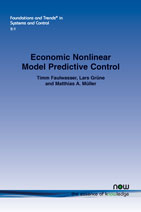Economic Nonlinear Model Predictive Control
By Timm Faulwasser, Karlsruhe Institute of Technology, Germany, timm.faulwasser@kit.edu | Lars Grüne, University of Bayreuth, Germany, lars.gruene@uni-bayreuth.de | Matthias A. Müller, University of Stuttgart, Germany, matthias.mueller@ist.uni-stuttgart.de
Abstract
In recent years, Economic Model Predictive Control (EMPC) has received considerable attention of many research groups. The present tutorial survey summarizes state-of-the-art approaches in EMPC. In this context EMPC is to be understood as receding-horizon optimal control with a stage cost that does not simply penalize the distance to a desired equilibrium but encodes more sophisticated economic objectives. This survey provides a comprehensive overview of EMPC stability results: with and without terminal constraints, with and without dissipativity assumptions, with averaged constraints, formulations with multiple objectives and generalized terminal constraints as well as Lyapunov-based approaches.
Economic Nonlinear Model Predictive Control
Model Predictive Control (MPC) can be dated back to the 1960s, and can now be regarded as a mature control method, which has had significant impact on industrial process control. It is applied in many control systems and has been extended to include non-linear dynamics and non-convex constraints.
Of increasing importance in all such control systems in the economic benefits within the design of the system. Traditionally, the so-called control pyramid has been the main technique to do this, whereby economic targets are translated into setpoints and reference trajectories, which are in turn stabilized by control techniques such as MPC. At the same time, in process systems engineering and other fields of application, one aims at economic process operation and much attention has been given to this and the term Economic Model Predictive Control (EMPC) has been coined.
Economic Nonlinear Model Predictive Control provides a concise overview of different approaches on the question of stability and optimality in different formulations of EMPC. It is the first monograph to cover approaches both with and without terminal constraints and end penalties, and turnpike/dissipativity-based settings as well as Lyapunov-based approaches.
This monograph is an accessible tutorial on the state-of-the-art in model predictive control. Students and researchers will find a clear exposition of current knowledge upon which they can build their own research.
